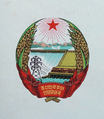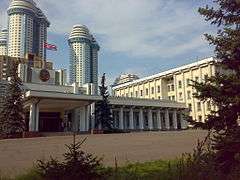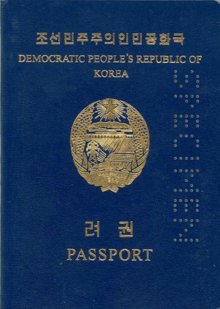Emblem of North Korea
The National Emblem of the Democratic People's Republic of Korea is the coat of arms of North Korea, officially known as the Democratic People's Republic of Korea. The current version adopted in 1993 is based on a design that was used since the foundation of the republic in 1948. Two previous versions were briefly in use in the late 1940s. Prominent features on the emblem are a red star, a hydroelectric plant (the Sup'ung dam) and Mount Paektu. The design bears similarities to the emblem of the Soviet Union and other emblems of the socialist heraldic style.
| National Emblem of the Democratic People's Republic of Korea 조선민주주의인민공화국의 국장 | |
|---|---|
 | |
| Armiger | Democratic People's Republic of Korea |
| Adopted | 1993 |
| Motto | Democratic People's Republic of Korea |
| Earlier version(s) | (1946), July 1948, September 1948 |
 |
| Part of a series on the |
| Culture of Korea |
|---|
| History |
|
Festivals |
|
|
Music and performing arts |
|
Media
|
|
|
Monuments
|
|
National symbols of Korea
|
History
During the Liberation of Korea in 1945 by the Allies, Northern Korea had no emblem although the emblem of the People's Republic of Korea was used from 1945 to 1946. The first equivalent of an emblem appeared on January 1, 1946, printed below a speech of Kim Il-sung in the newspaper Chǒngro. It features the Korean Peninsula surrounded by a pattern of ribbons and wheat identical to that of the Soviet State Emblem. This was the only time it was ever used, and between 1946 and 1948 a simple outline of the peninsula was displayed in its place. This was intended to signal that the North and the South are one country.[1]
However, in July 1948 as the division of Korea loomed, North Korea adopted its first constitution. This constitution defined the North Korean emblem, but the emblem was in use for only two months. It features a furnace, as opposed to a hydroelectric plant on later designs.[1]
On September 9, 1948, the Democratic People's Republic of Korea was declared and a new emblem adopted. This is evident in the chosen motif: the Sup'ung hydroelectric plant was built by the Imperial Japanese during their colonial rule over the Korean Peninsula, and as such was not comfortable as symbol of national pride for nationalistic Koreans. However, North Korean sources claim that Kim Il-sung was behind the design. In 1993, the emblem was further amended to feature Mount Paektu. The mountain is an important symbol of power and legitimacy of the Kim family dynasty in North Korean propaganda,[1] and is especially identified with Kim Jong-il because it is where official narratives place his birth. The adoption of that symbol testified to the rise of his status.[2]
 Emblem of the People's Republic of Korea from 1945 to 1946.
Emblem of the People's Republic of Korea from 1945 to 1946..svg.png) Reconstruction of the first equivalent of an emblem published in Chǒngro in 1946.
Reconstruction of the first equivalent of an emblem published in Chǒngro in 1946..svg.png) The emblem defined by the 1948 constitution but only used for two months.
The emblem defined by the 1948 constitution but only used for two months..svg.png) The emblem used from the founding of North Korea until 1993 features a generic mountain range.
The emblem used from the founding of North Korea until 1993 features a generic mountain range. A variant of the emblem printed by the Foreign Languages Publishing House in 1960, showing the generic mountain range, as well as the design of the dam typical of the post-1993 standard.
A variant of the emblem printed by the Foreign Languages Publishing House in 1960, showing the generic mountain range, as well as the design of the dam typical of the post-1993 standard. Emblem used by the Chairman of the State Affairs Commission (2016–present).
Emblem used by the Chairman of the State Affairs Commission (2016–present).
Features
Article 169 of the Socialist Constitution of the Democratic People's Republic of Korea (1972, amended 2013)[3]
The emblem features the Sup'ung dam under Mount Paektu and a power line as the escutcheon. The crest is a five-pointed red star. It is supported with ears of rice, bound with a red ribbon bearing the inscription "The Democratic People's Republic of Korea" in Chosongul characters.[4]
While the design of the hydroelectric plant is generic in appearance,[5] its identity is given away by the fact that Sup'ung was the only power station of its kind at the time when the emblem was designed.[1] Sup'ung was constructed by the Japanese and is located in what is today the border with the People's Republic of China. In spite of the uncomfortable reference to colonial infrastructure as well as foreign territory,[5] the choice of the image is not incidental and carries positive connotations. In the late 1940s, the North produced most of the electricity in the country.[6] The dam symbolizes self-sufficiency in electricity: in the spring of 1948 shortly before the hydroelectric plant was added to the emblem, North Korea cut off her power network from the South.[5]
The emblem, and all of its predecessors, follows the basic socialist heraldic design that was adopted in many other countries including, which clearly indicates the relations between the communist ideology and the foundation of the country at the onset of the Cold War.[1]
- Emblem at the North Korean embassy in Prague, Czech Republic.
- Emblem at the fence of the North Korean embassy in Prague, Czech Republic.
 The emblem above the entrance to the North Korean embassy in Moscow.
The emblem above the entrance to the North Korean embassy in Moscow.
See also
References
- Fyodor Tertitskiy (September 23, 2014). "The Evolution of North Korea's Coat of Arms". DailyNK. Retrieved August 2, 2015.
- Tertitskiy, Fyodor (April 10, 2018). "What North Korea's army flags can teach us about its recent history". NK News. Retrieved September 9, 2018.
- Socialist Constitution of the Democratic People's Republic of Korea. Amended and supplemented on April 1, Juche 102 (2013), at the Seventh Session of the Twelfth Supreme People's Assembly. Pyongyang: Foreign Languages Publishing House. 2014. p. 35. ISBN 978-9946-0-1099-1. Archived from the original (PDF) on June 8, 2016.CS1 maint: others (link)
- North Korea: A Country Study. Government Printing Office. p. 196. ISBN 978-0-16-088278-4.
- Rüdiger Frank; Jim Hoare; Patrick Kölner; Susan Pares (2009). Korea Yearbook (2009): Politics, Economy and Society. BRILL. pp. 122–123. ISBN 90-04-18019-2.
- Oliver Hotham (May 22, 2015). "Lights out in Pyongyang? North Korea's energy crisis". NK News. Retrieved August 3, 2015.
Further reading
- 100 Questions and Answers: Do You Know about Korea?. Pyongyang: Foreign Languages Publishing House. 1989. OCLC 21301721.
External links
| Wikimedia Commons has media related to Coats of arms of North Korea. |